เชื้อไข้หวัดใหญ่มีอยู่สองสายพันธ์คือ ไข้หวัดใหญ่สายพันธุ์ A และ B เป็นสายพันธุ์ที่พบได้ทั่วโลก แต่ไข้หวัดใหญ่สายพันธุ์ A มักจะรุนแรงมากกว่า เพราะมีโอกาสระบาดใหญ่ทั่วโลกอย่าง เช่นไข้หวัดนก ไข้หวัดใหญ่ 2009 อันที่จริงแล้ว ไข้หวัดใหญ่สามารถเกิดขึ้นได้ทั้งปี แต่ไข้หวัดใหญ่สายพันธุ์ B ครั้งนี้เป็นไข้หวัดตามฤดูกาล โดยส่วนมากจะระบาดในช่วงฤดูหนาว เพราะเชื้อไวรัสไข้หวัดใหญ่จะเจริญเติบโตได้ดีในอากาศเย็น ซึ่งพบมากที่สุดช่วงเดือนธันวาคมและมกราคม และฤดูฝน คือ ช่วงเดือนสิงหาคม อาการของไข้หวัดใหญ่จะเป็นแบบเฉียบพลัน ผู้ป่วยจะมีไข้สูงมากถึง 40 องศาเซลเซียส ปวดเมื่อยตามตัว คัดจมูก มีน้ำมูก เจ็บคอและไอ หากมีภาวะแทรกซ้อนก็จะเกิดภาวะปอดอักเสบได้ ระยะเวลาป่วยประมาณ 6-7 วัน ไข้หวัดใหญ่สายพันธุ์ B สามารถพบได้ทุกช่วงวัย แต่กลุ่มที่มีความเสี่ยง ต้องระมัดระวังเป็นพิเศษคือ ผู้ป่วยโรคปอดเรื้อรัง โรคหอบหืด โรคหัวใจ โรคภาวะภูมิคุ้มกันบกพร่อง เด็กเล็กอายุน้อยกว่า 2 ปี ผู้สูงอายุและหญิงตั้งครรภ์ รวมถึงผู้ที่มีดัชนีมวลกายเยอะหรือโรคอ้วน หากเป็นไข้หวัดใหญ่ ก็มีความเสี่ยงที่จะมีอาการรุนแรงกว่าปกติ
นอกจากเชื้อไข้หวัดสายพันธ์ A และ B ก็ยังมีการติดเชื้อ โคโรน่าไวรัส และเกิดระบาดถึงสองครั้งได้แก่ ไข้หวัดมรณะหรือ SARS และไข้หวัด MERSประเทศจีนได้รายงานการระบาดของไข้หวัดโคโรน่าไวรัสสายพันธุ์ใหม่ 2019 nCoV ที่เมื่อง อู่ฮั่น มณฑลหูเป่ย และมีหลักฐานว่าติดต่อจากคนสู่คน และระบาดไปยังหลายเมืองของจีน นอกจากนั้นก็ยังพบผู้ป่วยคนจีนที่เดินทางไปยังหลายประเทศ โดยมีอาการสำคัญคือ ไข้ น้ำมูกไหล ไอ หากรุนแรงจะมีอาการปอดบวม ซึ่งขณะนี้ยังไม่ทราบวิธีการแพร่เชื้อ
โคโรน่าไวรัสเป็นไวรัสขนาดใหญ่ และ เป็นกลุ่มใหญ่ ดูด้วยกล้องจุลทรรศน์อิเล็กตรอน คล้ายมงกุฎ จึงเรียกว่าโคโรนาไวรัส พบได้ทั้งใน คน และ สัตว์ จำนวนมาก โคโรน่าไวรัสโดยปกติไม่ค่อยทำให้เกิดโรคในคน แต่ก็อาจจะเกิดระบาดได้ ที่เกิดโรคในคน แต่เดิมมี 6 ชนิด เป็นสายพันธุ์ที่พบดั้งเดิม ทำให้เกิดโรคหวัด และทางเดินหายใจอยู่เป็นประจำถิ่น แล้ว มี 4 ชนิด และอุบัติใหม่ ทำให้เกิดโรคทางเดินหายใจอักเสบ แบบเฉียบพลันคือ SARS-Cov โคโรน่าไวรัส และ MERS-CoV ซึ่งเป็นโรคที่ค่อนข้างรุนแรง มีอัตราการเสียชีวิตสูง 10 และ 30 % ตามลำดับ จุดกำเนิดของโคโรน่าไวรัสสายพันธุ์ใหม่ปอดบวมอู่ฮั่น ผู้ป่วยกลุ่มแรกที่พบ ส่วนใหญ่มีแหล่งสัมผัส จากตลาดสดที่มีการขายอาหารทะเล และสัตว์สิ่งมีชีวิต โคโรน่าไวรัสสายพันธุ์ใหม่เช่นเดียวกันกับ ไวรัสที่ทำให้เกิดโรคทางเดินหายใจอักเสบ มีได้ทั้งแบบไม่มีอาการ มีอาการทางเดินหายใจอักเสบแบบเฉียบพลัน จนถึงปอดบวมและโรคแทรกซ้อนระยะฟักตัวของโรค โดยทั่วไปโคโรน่าไวรัส จะมีระยะฟักตัวประมาณ 2 ถึง 7 วัน ในทางปฏิบัติการเฝ้าสังเกตอาการหลังสัมผัสโรค หรือมาจากแหล่งระบาดของโรค เราจึงใช้ 2 เท่า คือ 14 วัน
อาการของไข้หวัดสายพันธ์ใหม่
Symptoms of the new coronavirus include fever, cough and difficulty breathing. These symptoms are similar to those caused by SARS, according to a recent study published in the journal The Lancet.
Despite sharing some symptoms that were similar to SARS, there "are some important differences," such as the absence of upper respiratory tract symptoms like runny nose, sneezing and sore throat and intestinal symptoms like diarrhea, which affected 20% to 25% of SARS patients, lead author Bin Cao, from the China-Japan Friendship Hospital and the Capital Medical University, both in Beijing, said in a statement.
How many people have the new virus?
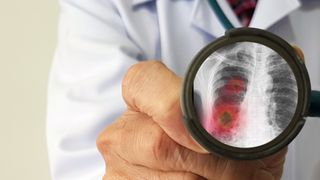
As of Jan. 25, there are nearly 1,300 confirmed cases and 41 deaths linked to the 2019-nCoV virus in China, according to The New York Times. On Jan. 24, the second person in the United States (a woman in Chicago) was confirmed to have the virus; the first case was confirmed in a man in Washington state. Both individuals had recently returned from Wuhan.
How far has the virus spread?

The first cases of the pneumonia-like virus were reported in Wuhan, China on Dec. 31, 2019. Since then, the virus has spread to various other countries, including Thailand, Japan, the Republic of Korea, the United States, Australia, France, among others.
The first U.S. case was confirmed on Jan. 21 in a man in Washington state who had recently traveled to Wuhan. On Jan. 24, officials confirmed a second case in a woman from Chicago who had also recently traveled to the Chinese city. Both cases were hospitalized, but doing well, officials said.
The CDC is also investigating more than 60 people in 22 states for a possible infection with the new virus, officials said Friday (Jan. 24). Eleven of those people have so far tested negative for the virus.
Where did the virus come from?

Since the virus first popped up in Wuhan in people who had visited a local seafood and animal market, officials could only say it likely hopped from an animal to humans. In a new study, however, researchers sequenced the genes of 2019-nCoV (as the virus is now called), and then they compared it with the genetic sequences of more than 200 coronaviruses that infect various animals around the world. Their results, detailed in the Journal of Medical Virology, suggested that 2019-nCoV likely originated in snakes.
As for what kind of snake, the scientists noted there are two snakes that are common to southeastern China where the outbreak originated: the many-banded krait (Bungarus multicinctus) and the Chinese cobra (Naja atra).
However, some experts have criticized the study, saying it's unclear if coronaviruses can indeed infect snakes.
How did the virus hop from animals to humans?

Some viruses are known to become capable of transmitting to humans, and this coronavirus is one of those. But how? The study published in the Journal of Medical Virology, revealing the likely snake host, also found that a change to one of the viral proteins in 2019-nCoV allows the virus to recognize and bind to receptors on certain host cells. This ability is a critical step to entering cells, and the researchers said that the change in this particular protein may have helped the virus hop to humans.
Can the virus spread between people?

Yes, in limited cases, according to the CDC, but the primary mode of transmission seems to be from animal to human. In terms of how one would catch the virus, the CDC says that human coronaviruses are most commonly spread between an infected person and others via:
—the air (from viral particles from a cough or sneeze);
—close personal contact (touching or shaking hands);
—an object or surface with viral particles on it (then touching your mouth, nose or eyes before washing your hands);
—and rarely from fecal contamination.
How would this virus cause a pandemic?
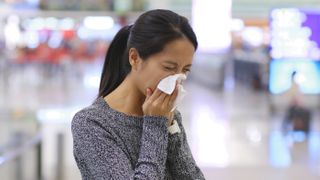
In order for this virus, or any, to lead to a pandemic in humans, it needs to do three things: efficiently infect humans, replicate in humans and then spread easily among humans, Live Science previously reported. Right now, the CDC is saying this virus passes between humans in a limited manner, but they are still investigating.
How does the virus compare to SARS and MERS?
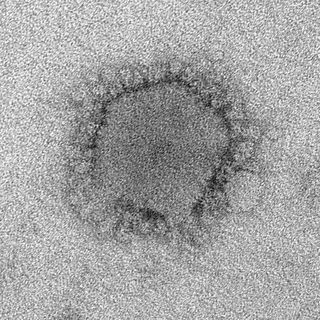
MERS and SARS have both been known to cause severe symptoms in people. It's unclear how the new coronavirus will compare in severity, as it has caused severe symptoms and death in some patients while causing only mild illness in others, according to the CDC. All three of the coronaviruses can be transmitted between humans through close contact.
MERS, which was transmitted from touching infected camels or consuming their meat or milk, was first reported in 2012 in Saudi Arabia and has mostly been contained in the Arabian Peninsula, according to NPR. SARS was first reported in 2002 in southern China (no new cases have been reported since 2004) and is thought to have spread from bats that infected civets. The new coronavirus was likely transmitted from touching or eating an infected animal in Wuhan.
During the SARS outbreak, the virus killed about 1 in 10 people who were infected. The death rate from 2019-nCoV isn't yet known, although most of the patients who have died from the infection have been older than 60 and have had preexisting conditions. However, more recently, a young healthy man died in Wuhan, raising concern that the virus might be more dangerous than thought, according to The Washington Post.
There are no specific treatments for coronavirus infections and most people will recover on their own, according to the CDC. So treatment involves rest and medication to relieve symptoms. A humidifier or hot shower can help to relieve a sore throat and cough. If you are mildly sick, you should drink a lot of fluids and rest but if you are worried about your symptoms, you should see a healthcare provider, they wrote. (This is advice for all coronaviruses, not specifically aimed toward the new virus).
There is no vaccine for the new coronavirus but researchers at the U.S. National Institutes of Health confirmed they were in preliminary stages of developing one. In addition, the drug company Regeneron announced that it is in the early stages of developing a treatment for this virus, according to NBC News.
What is being done to stop the spread of the coronavirus?
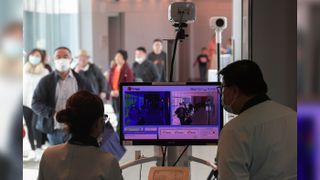
The Chinese government has stopped most of the travel to and from Wuhan as well as 12 other nearby cities, according to The New York Times. This "lockdown" affects about 35 million people, the Times reported.
Major airports in the U.S. are conducting screenings to make sure incoming passengers aren't infected. However, U.S. officials said on Friday (Jan. 24) that they are currently reevaluating the effectiveness of this screening.
The CDC also recommends avoiding nonessential travel to Wuhan. On Jan. 23, the U.S. State Department ordered all non-emergency U.S. personnel and family to leave Wuhan, the department said in a statement.
What do we expect in the coming days?

Looking at what happened with MERS and SARS, it's likely that some spread of the virus from close contact between humans will continue to occur, according to CDC. More cases — possibly including some in the U.S. — will likely be identified in the coming days.
How can people protect themselves and others?
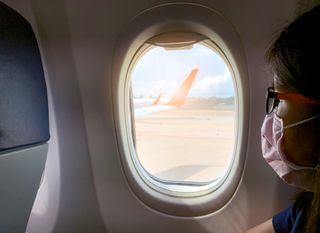
If traveling to Wuhan, you should avoid contact with sick people, avoid dead or alive animals, animal markets or products that come from animals such as uncooked meat, according to the CDC. You should often wash hands with soap and water for at least 20 seconds, they wrote. If you are infected by the virus you can take steps to help avoid transmitting it to others such as isolating yourself at home, separating yourself from other people in the house, wearing a face mask, covering your coughs and sneezes and washing your hands, according to the CDC.
People who traveled to Wuhan and became sick with fever, cough or difficulty breathing within the following two weeks should seek medical care right away, and call ahead to inform medical staff about their recent travel.
Rachael Rettner contributed reporting.
In early 2020, a new virus began generating headlines all over the world because of the unprecedented speed of its transmission.
From its origins in a food market in Wuhan, China, in December 2019 to countries as far-flung as the United States and the Philippines, the virus (officially named SARS-CoV-2) has affected hundreds of thousands, with a rising death toll now over 17,000.
The disease caused by an infection with SARS-CoV-2 is called COVID-19, which stands for coronavirus disease 2019.
In spite of the global panic in the news about this virus, you’re unlikely to contract SARS-CoV-2 unless you’ve been in contact with someone who has a SARS-CoV-2 infection.
Let’s bust some myths. Read on to learn how this 2019 coronavirus is spread, how it’s similar and different from other coronaviruses, and how to prevent spreading it to others if you suspect you’ve contracted this virus.
HEALTHLINE’S CORONAVIRUS COVERAGEStay informed with our live updates about the current COVID-19 outbreak. Also, visit our coronavirus hub for more information on how to prepare, advice on prevention and treatment, and expert recommendations.
Doctors are learning new things about this virus every day. So far, we know that COVID-19 may not initially cause any symptoms for some people.
You may carry the virus for 2 days or up to 2 weeksTrusted Source before you notice symptoms.
Some common symptoms that have been specifically linked to COVID-19 include:
These symptoms may become more severe in some people. Call emergency medical services if you or someone you care for have any of the following symptoms:
The full list of symptoms is still being investigated.
COVID-19 versus the flu
We are still learning about whether the 2019 coronavirus is more or less deadly than the seasonal flu.
This is difficult to determine because the number of total cases (including mild cases in people who don’t seek treatment or get tested) is unknown. However, early evidence suggests that this coronavirus causes more deaths than the seasonal flu.
An estimated 0.06 to 0.1 percentTrusted Source of people who developed the flu during the 2019-2020 flu season in the United Stated died (as of March 14, 2020). This is compared to 1.2 percent of those with a confirmed case of COVID-19 in the United States, according to the Centers for Disease Control and Prevention (CDC)Trusted Source .
Here are some common symptoms of the flu:
Coronaviruses are zoonotic. This means they first develop in animals before developing in humans.
For the virus to pass from animal to humans, a person has to come into close contact with an animal that carries the infection.
Once the virus develops in people, coronaviruses can be spread from person to person through respiratory droplets. This is a technical name for the wet stuff that moves through the air when you cough or sneeze.
The viral material hangs out in these droplets and can be breathed into the respiratory tract (your windpipe and lungs), where the virus can then lead to an infection.
The 2019 coronavirus hasn’t been definitively linked to a specific animal.
Researchers believe that the virus may have been passed from bats to another animal — either snakes or pangolins — and then transmitted to humans. This transmission likely occurred in the open food market in Wuhan, China.
You’re at high risk for contracting SARS-CoV-2 if you come into contact with someone who’s carrying it, especially if you’ve been exposed to their saliva or been near them when they’ve coughed or sneezed.
Without taking proper prevention measures, you’re also at high risk if you:
HANDWASHING IS KEYWashing your hands and disinfecting surfaces can help decrease your risk for catching this and other viruses.
Older people and people with certain health conditions have a higher risk for severe complications if they contract the virus. These health conditions include:
Pregnant women have a higher risk of complicationsTrusted Source from other viral infections, but it’s not yet known if this is the case for the 2019 coronavirus.
COVID-19 can be diagnosed similarly to other conditions caused by viral infections: using a blood, saliva, or tissue sample. However, most tests use a cotton swab to retrieve a sample from the inside of your nostrils.
Tests are conducted by the CDC, some state health departments, and some commercial companies. See your state’s health department websiteTrusted Source to find out where testing is offered near you.
Talk to your doctor right away if you think you have COVID-19 or you notice symptoms. Your doctor will advise you on whether you should stay home and monitor your symptoms, come in to the doctor’s office to be evaluated, or go to the hospital for more urgent care.
There’s currently no treatment specifically approved for COVID-19, and no cure for an infection, although treatments and vaccines are currently under study. Instead, treatment focuses on managing symptoms as the virus runs its course.
Seek immediate medical help if you think you have COVID-19. Your doctor will recommend treatment for any symptoms or complications that develop.
Other coronaviruses like SARS and MERS are also treated by managing symptoms. In some cases, experimental treatments are tested to see how effective they are. Examples of therapies used for these illnesses include:
The most serious complication of a SARS-CoV-2 infection is a type of pneumonia that’s been called 2019 novel coronavirus-infected pneumonia (NCIP).
Results from a 2020 studyTrusted Source of 138 people admitted into hospitals in Wuhan, China, with NCIP found that 26 percent of those admitted had severe cases and needed to be treated in the intensive care unit (ICU).
About 4.3 percent of these people who were admitted to the ICU died from this type of pneumonia. It should be noted that people who were admitted to the ICU were on average older and had more underlying health conditions than people who didn’t go to the ICU.
So far, NCIP is the only complication specifically linked to the 2019 coronavirus. Researchers have seen the following complications in people who have developed COVID-19:
The best way to prevent the spread of infection is to avoid or limit contact with people who are showing symptoms of COVID-19 or any respiratory infection.
The next best thing you can do is practice good hygiene and social distancing to prevent bacteria and viruses from spreading.
Prevention tips
A coronavirus gets its name from the way it looks under a microscope.
The word corona means “crown,” and when examined closely, the round virus has a “crown” of proteins called peplomers jutting out from its center in every direction. These proteins help the virus identify whether it can infect its host.
The condition known as severe acute respiratory syndrome (SARS) was also linked to a highly infectious coronavirus back in the early 2000s. The SARS virus has since been contained.
COVID-19 vs. SARS
This isn’t the first time a coronavirus has made news — the 2003 SARS outbreak was also caused by a coronavirus.
As with the 2019 virus, the SARS virus was first found in animals before it spread to humans.
The SARS virus is thought toTrusted Source have come from bats and then transferred to another animal, and then to humans.
Once transmitted to humans, the SARS virus began spreading quickly among people.
What makes the novel coronavirus so newsworthy is that a treatment or cure hasn’t yet been developed to help prevent its rapid spread from person to person. SARS has been successfully contained.
First and foremost, don’t panic. You don’t need to wear a mask or be quarantined unless you suspect you have contracted the virus or have a confirmed test result.
Following simple handwashing and social distancing guidelines may help protect you from being exposed to the virus.
The 2019 coronavirus probably seems scary when you read the news about new deaths, quarantines, and travel bans.
Stay calm and follow your doctor’s instructions if you’re diagnosed with COVID-19 so you can recover and help prevent it from spreading.
Call your primary care provider and discuss symptoms before visiting a healthcare facility, or click below to find a local provider. If this is an emergency, call 911, and tell the operator you have COVID-19.
23 sourcescollapsed

Know the Symptoms
COVID-19 is a respiratory illness with symptoms similar to the flu. Symptoms are typically mild to moderate, but there have been cases of severe illness and death due to the virus. The following symptoms may appear 2-14 days after exposure.
Steps to Take for Mild Symptoms
For people who think they might have COVID-19 and have mild symptoms, the Centers for Disease Control and Prevention now recommends they stay home and call their doctor if they need medical advice. Learn more in this NCDHHS fact sheet in EnglishOpen PDF and SpanishOpen PDF. When people with mild illness leave their homes to get tested, they could expose themselves to COVID-19 if they do not already have it. If they do have COVID-19, they can give it to someone else, including people who are high risk and health care providers who will be needed to care for people with more severe illness. In addition, because there is no treatment for COVID-19, a test will not change what someone with mild symptoms will do.
Steps to Take for Serious Symptoms
Anyone with more serious symptoms should seek medical attention immediately, by calling their doctor or 911 right away. More serious symptoms can include trouble breathing, persistent pain or pressure in the chest, new confusion or inability to arouse, bluish lips or face.
When Can I Return to Normal Activities?
People who are sick with COVID-19 or believe they might have it should stay home and separate themselves from other people in the home as much as possible. They can go back to their normal activities when they can answer YES to all the following questions:
Limit Exposure
Household members and people who have been in close contact with someone who has had symptoms of COVID-19 should stay home as much as possible for 14 days and monitor themselves for symptoms. Close contact means within six feet for at least 10 minutes. If they start having symptoms of COVID-19, they should take the same steps to prevent spreading it.
Coronaviruses like COVID-19 are most often spread through the air by coughing or sneezing, through close personal contact (including touching and shaking hands) or through touching your nose, mouth or eyes before washing your hands. NCDHHS recommends that persons experiencing fever and cough should stay at home and not go out until their symptoms have completely resolved.
The Centers of Disease Control and Prevention (CDC) has actions you can take to prevent others from getting sick. This includes:
Know the Difference: Self-monitor, Quarantine and Isolation
These are protective measures used to prevent the spread of COVID-19 among people who may have been exposed.
Advice for people at higher risk-Coronavirus (COVID-19)
Contents
Coronavirus can make anyone seriously ill. But some people are at a higher risk and need to take extra steps to avoid becoming unwell.
People at increased risk
You may be at increased risk from coronavirus if you:
Conditions that may increase your riskHow to protect yourself from coronavirus
The advice for people who may be at increased risk from coronavirus is the same as for most other people.
You should only leave the house for very limited purposes:
Pregnancy advice
If you're pregnant and worried about coronavirus, you can get specific advice about coronavirus and pregnancy from the Royal College of Obstetricians and Gynaecologists.
People most at risk
People most at risk from coronavirus are sometimes called "shielded" or "extremely vulnerable" people.
This includes people who:
People most at risk are being contacted by the NHS.
Speak to your GP or care team if you have not been contacted and think you should have been.
How to protect yourself from coronavirus
People most at risk from coronavirus need to take extra steps to avoid getting it. This is known as "shielding".
It's recommended you follow this advice for at least 12 weeks.
Do
Don't
How to look after your wellbeing
Staying at home and reducing contact with other people can be hard.
There are things you can try to help you to stay well:
See the full advice on protecting yourself from coronavirus if you're extremely vulnerable on GOV.UK.
People with certain health conditions
Some charities and organisations have worked with the NHS to produce specific advice about coronavirus.
Asthma – Asthma UK: coronavirus (COVID-19)
Other lung conditions, such as COPD – British Lung Foundation: coronavirus and COVID-19
Joint and muscle conditions, such as arthritis – Versus Arthritis: coronavirus (COVID-19)
Heart disease – British Heart Foundation: coronavirus – what it means for you if you have heart or circulatory disease
Stroke – Stroke Association: coronavirus (COVID-19) information for people affected by stroke
Page last reviewed: 3 April 2020
Next review due: 6 April 2020
รู้เขา-รู้เรา เข้าใจไวรัส ลดความเสี่ยงติดโควิด-19 นักวิจัยพบไวรัสโควิด-19 อยู่ในฝอยละลองได้หลายชั่วโมงอยู่บนพื้นผิวต่างๆ ได้หลายวัน
งานวิจัยจาก NIAID (National Institute of Allergy and Infectious Diseases)ศึกษารูปแบบการกระจายเชื้อ SARS-CoV-2 หรือโควิด-19 โดยจำลองการกระจายเชื้อ ผ่านฝอยละอองจากการไอ จาม หรือสัมผัสสู่พื้นผิวต่างๆ ตามบ้านเรือน หรือ โรงพยาบาล


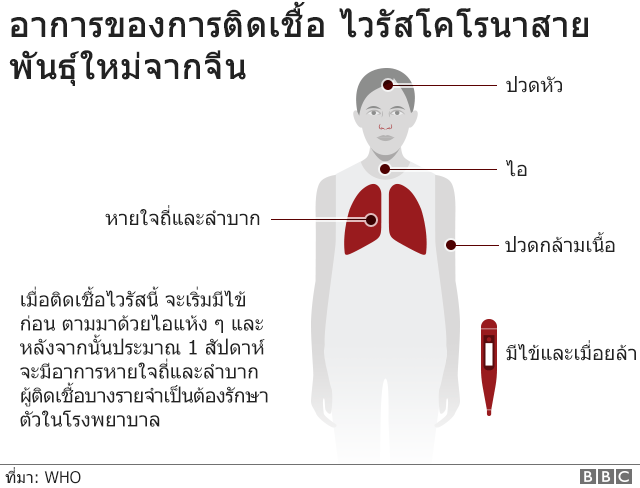
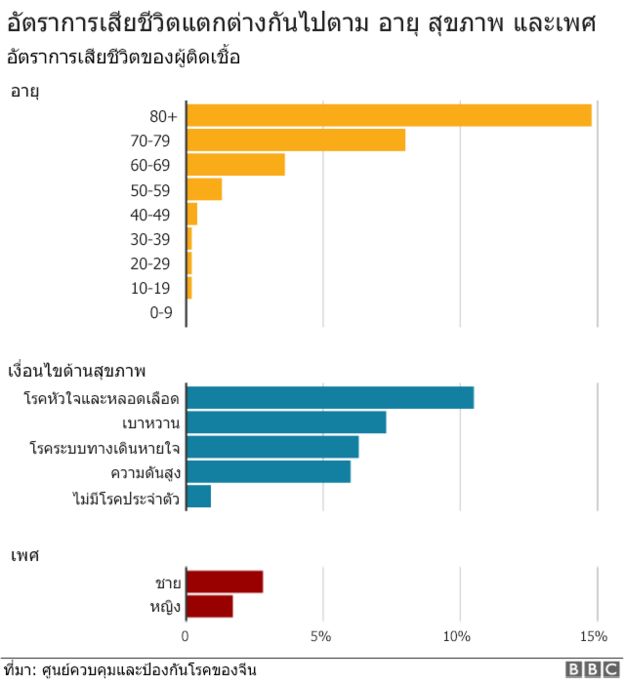
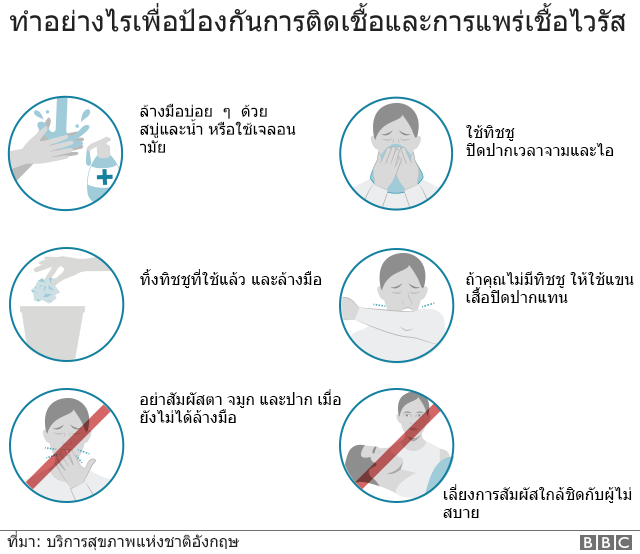
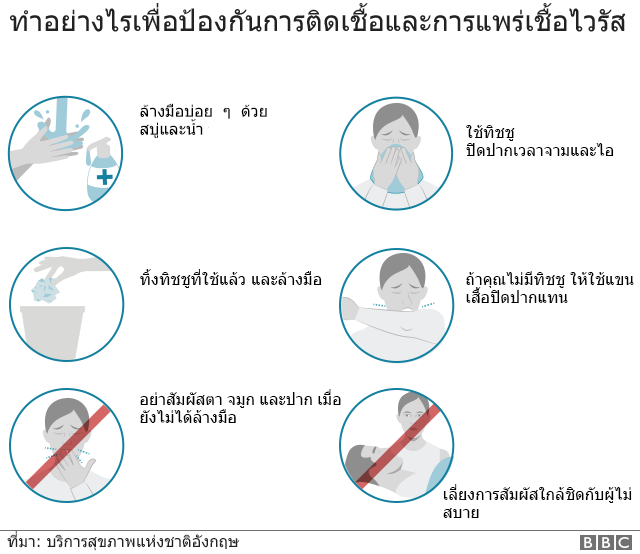

 Image copyrightGETTY CREATIVE STOCKคำบรรยายภาพผู้หญิงอาจมีภูมิคุ้มกันโรคสูงกว่าผู้ชาย เนื่องจากคุณสมบัตินี้จะช่วยเพิ่มโอกาสรอดชีวิตให้กับทารกแรกเกิด
Image copyrightGETTY CREATIVE STOCKคำบรรยายภาพผู้หญิงอาจมีภูมิคุ้มกันโรคสูงกว่าผู้ชาย เนื่องจากคุณสมบัตินี้จะช่วยเพิ่มโอกาสรอดชีวิตให้กับทารกแรกเกิด
 Image copyrightAFP/GETTY IMAGESคำบรรยายภาพจีนมีจำนวนผู้สูบบุหรี่สูงที่สุดในโลกถึง 316 ล้านคน ซึ่งในจำนวนนี้ส่วนใหญ่เป็นผู้ชาย
Image copyrightAFP/GETTY IMAGESคำบรรยายภาพจีนมีจำนวนผู้สูบบุหรี่สูงที่สุดในโลกถึง 316 ล้านคน ซึ่งในจำนวนนี้ส่วนใหญ่เป็นผู้ชาย